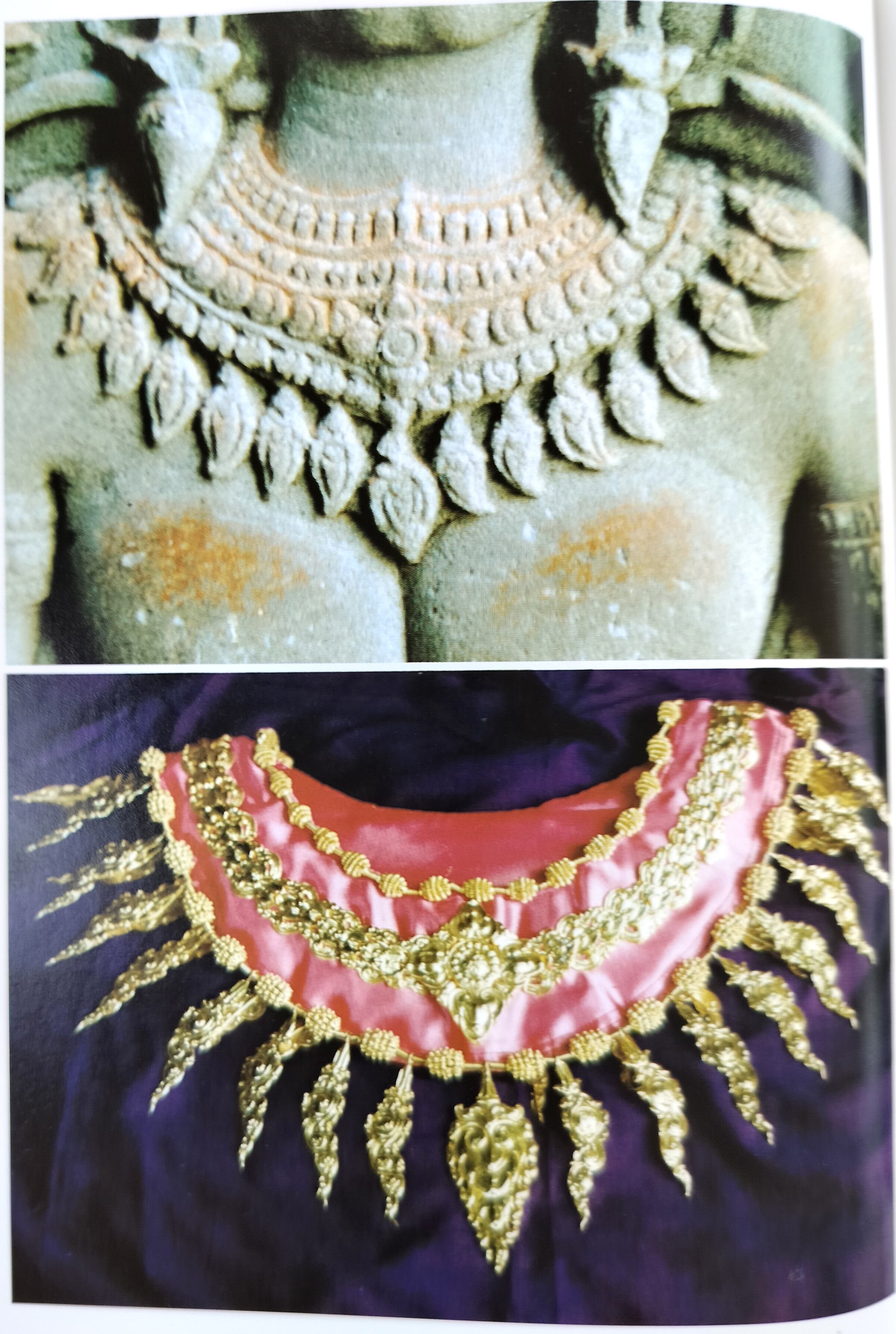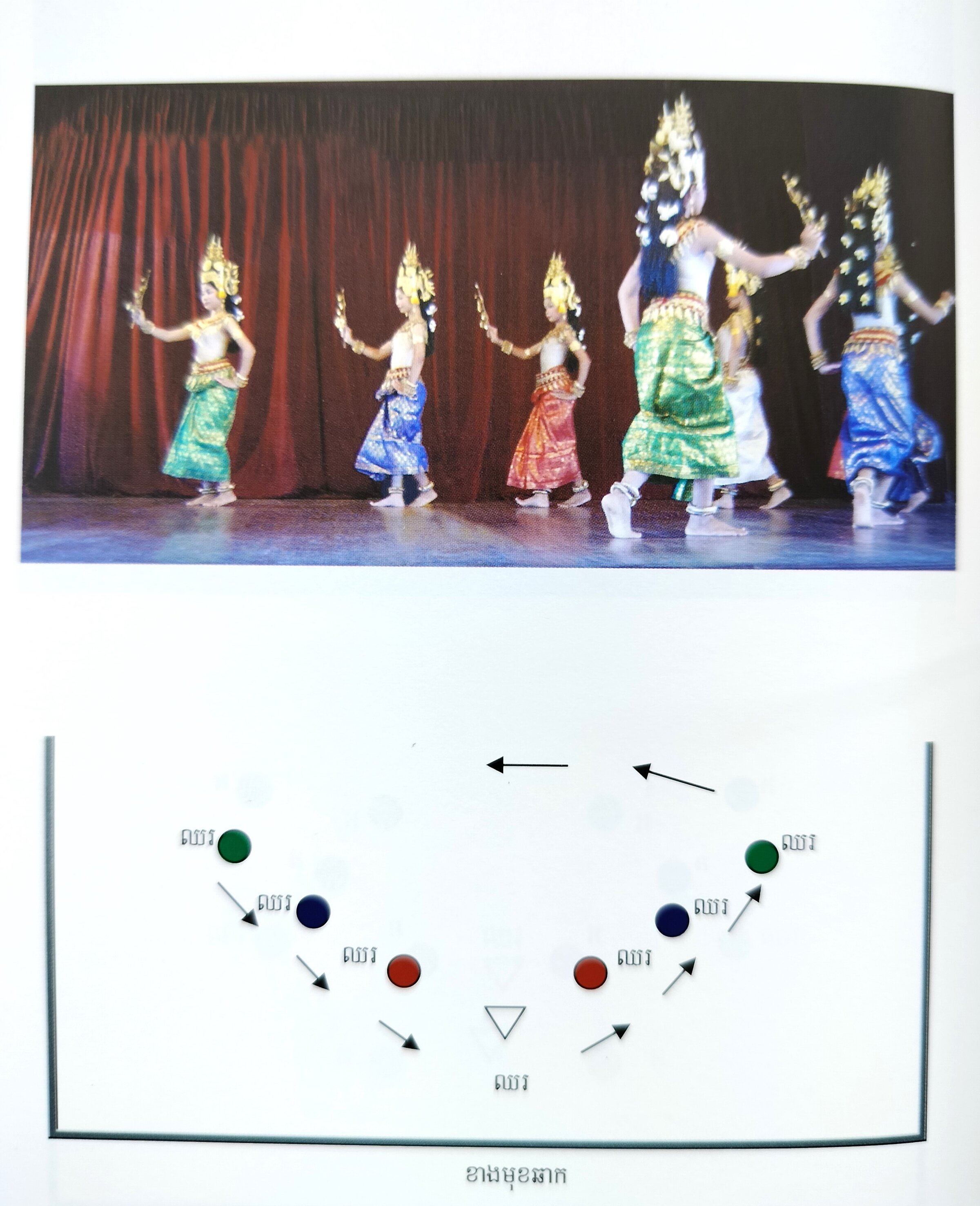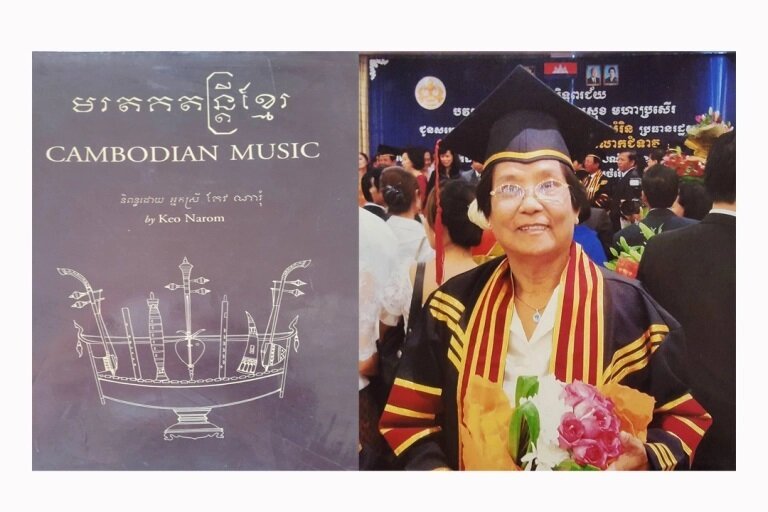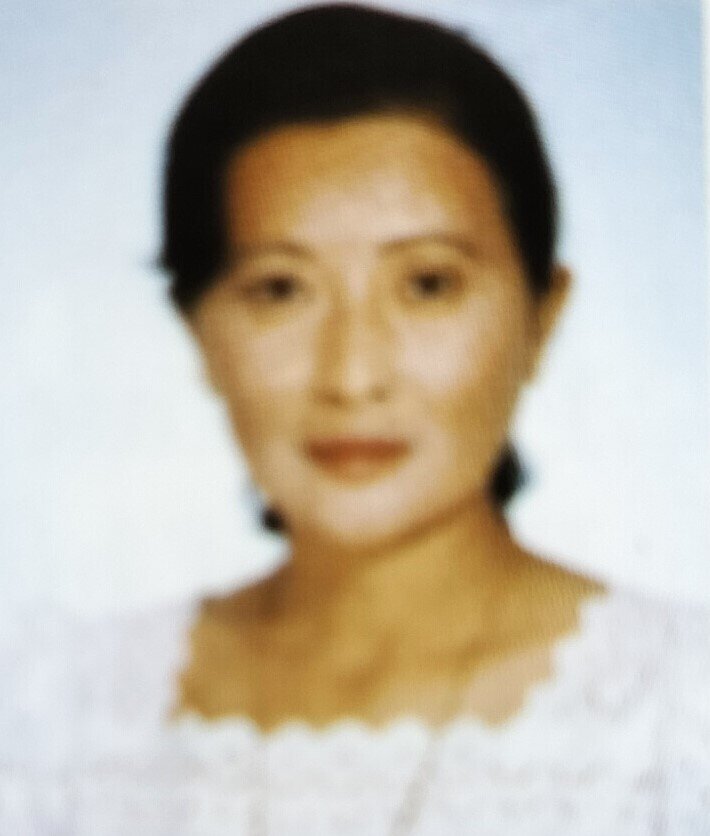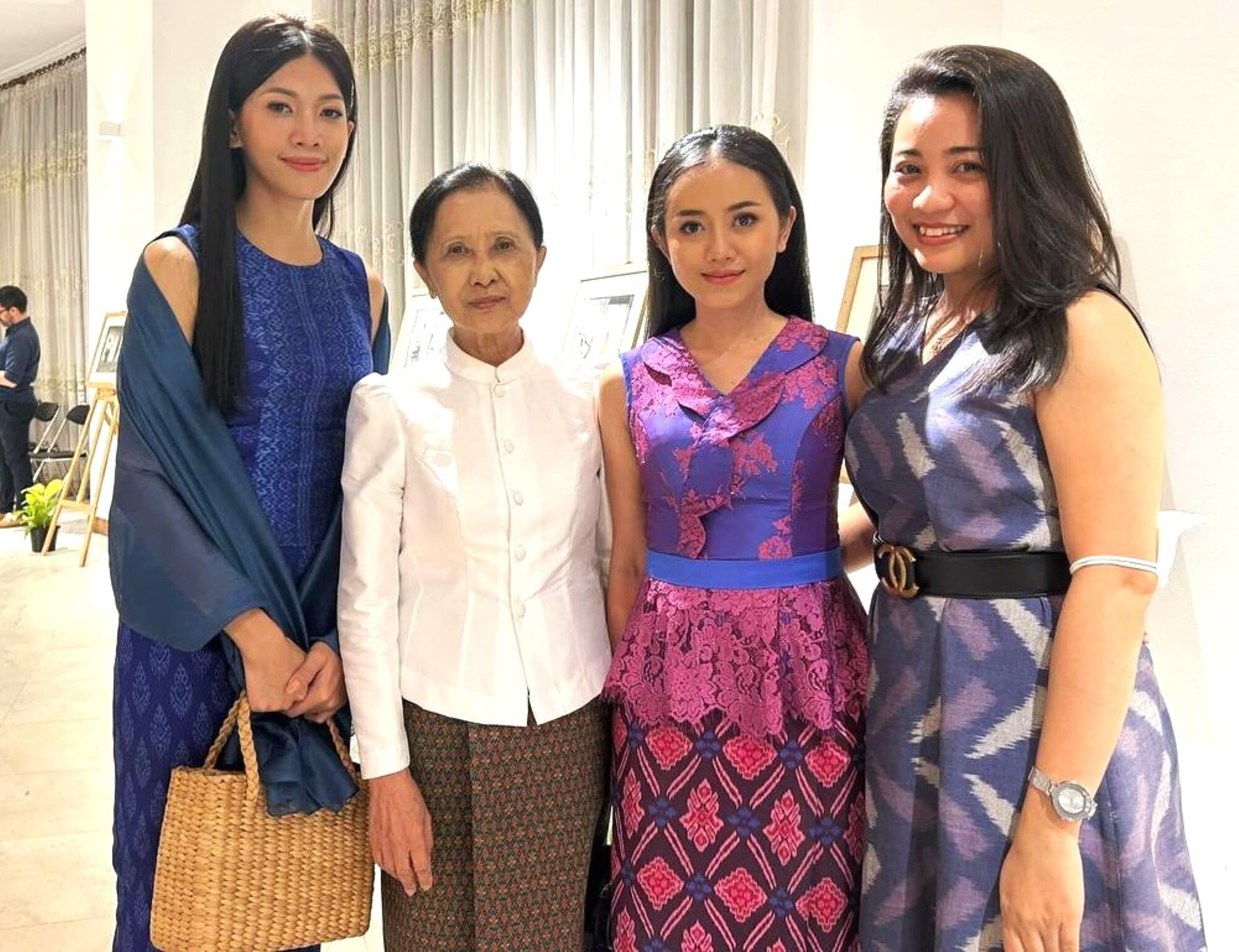Apsara Dance | របាំអប្សរា
by Narom Keo & Sisaphanta Prum
A technical and historical treatise on Khmer classical dance.
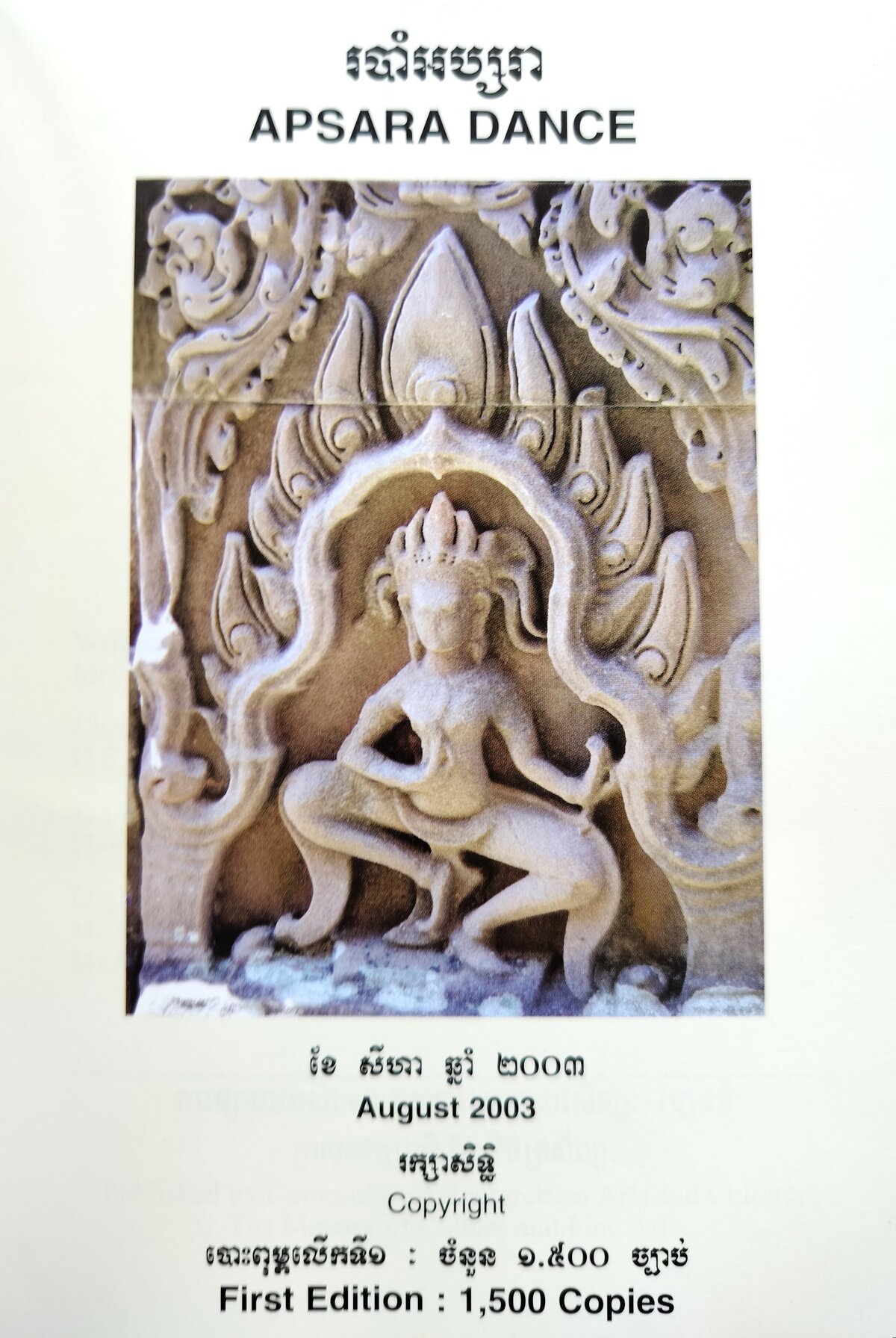
- Format
- hardback
- Publisher
- Research Committee on Arts and Culture, Ministry of Culture and Fine Arts, Phnom Penh
- Edition
- republication of 1994 edition.
- Published
- 2003
- Pages
- 116
- Languages
- English, Khmer
Dedicated to ‘HM Samdech Preah Moha Ksatryani Sisowath Kossamak Nearirath Sereivathana [Queen Kossamak, who conceived the style and repertoire of it is called Apsara Dance, Robam Apsara], HRH Preah Raja Kanitha Norodom Raksmei Sophorn [HRH Princess Norodom Rasmi Sobbhana]’, and to the authors’ beloved dance teacher Chea Samy [1], this essay does not pretend to be exhaustive, nor really structured treatise on dance — more likely, an ode to ‘Apsara, the pure and perfect version of woman […], the symbol of Khmer culture and matriarchy.”
Interestingly, the authors credit the creation of modern Apsara dance not directly to Queen Kossamak, Norodom Sihanouk’s mother — as most researchers do –, but to his aunt Rasmi Sobbhana (Raksmei Sophorn in Khmer): “Before 1970, study at all schools, especially primary ones, usually provided an award to hard working students at the end of the academic year. At the event, students performed dances that they had practiced over the academic year. Sothearos [Sutharot] School, under the leadership of the King’s aunt, Kanitha Norodom Raksmei Sophorn, created a new dance called ‘Apsara’ for performance at the school in 1958. The main dancers were King Sihanouk’s daughters — firstly Princess Norodom Vichara, then Princess Norodom Socheat Vatya. When the latter performed, the king would watch and after one performance he described what he had seen to his mother, Queen Kossamak, who had never seen Apsara dancing. When the queen asked, ‘Did she dance beautifully?’, the king answered that she could dance as well as her teacher, Professor Chea Samy. The king said that Socheat danced very well, and that her costume was very beautiful. […] Queen Kossamak asked Professor Chea Samy to bring her dancers and costumes from the school. The crown she brought was not made of fake gold, silver or copper like the crowns of today, but of hard paper sewed on cloth and cut into shape. […]
“At the time, the Apsara dance was similar to a dance called ‘Pourng Neary’, with music taken from the song ‘Dem Chheung’. Professor Chea Samy choreographed the dance and selected the music, Professors Chea Khan and Em Thay sang along with her. After Queen Kossamak had thought for a while, [she] was very pleased to invite all art professors to discuss the creation of a new Apsara dance much like the one we see today. Mr Hang Thunhak was the Queen’s assistant and there was also an old master, Sun Samai, who made accessories and crowns for the Apsara dancers, who were under the direction of a teacher named Teang Nov. Under the Queen’s innovative leadership, Apsara dance reached its peak and the new Apsara dance was first performed in Siem Reap province in order to make movie film by Mr Maxcelle Camus (?) [sic, Marcel Camus] in 1961 or 1962. At that time a very luxurious costume was made for the lead dancer, Princess Norodom Bopha Devi, which is similar to the present Apsara lead dancer costume. […] A close relationship formed between the Kingdom of Cambodia and the People’s Republic of China because a Chinese dancer named Chang Tchoung practiced the Apsara dance. […]
“The following are the main Apsara dancers: Princess Norodom Bopha Devi, Mrs Seng Sreimom, Mrs Van Savai, Mrs Dhok Thach, Mrs Van Savong, Mrs Yim Tevi, Mrs Mom Kaknika, Mrs Ouk Phalla, Ms Sok Sokheung.”
Musical scores and song lyrics, choreography charts, costumes and accessories — with numerous illustrations showing how the modern Apsara costume has been drawn from Angkor bas-reliefs — , have been added to the brief chapters describing the principles of Apsara dance. Keepers of the tradition, the authors also give a list of physical requirements for lead Apsara dancer, ជាតួនាង, chea tuorneang, literally “in the she-character”, the embodiment of female grace and poise in Khmer classical dance: “body should be small and attractive, and not too tall, a round body like the body of a red ant. Limbs are smooth and long. Hips must neither be too large or too small, like the bottom of a coconut.” In addition, the ‘goddess, princess or queen’ character, Reuk Neang Kasat, “doesn’t even smile, she has sharp eyes.”
[1] Chea Samy (3 Aug 1919, Prey Char Village, Kompong Cham Province — 1994, Phnom Penh) was a Royal Ballet dancer since age 6 who performed at King Sisowath’s funerals in 1927. She became a secondary school teacher in 1948 but kept performing in China, France, URSS, North Korea, Indonesia, Czechoslovakia, Burma, Thailand, the USA, and taught classical dance in Cambodia. From 1979 to 1994, she taught traditional and classical dance at RUFA.
Tags: dance, dancers, Royal Ballet of Cambodia, Cambodian dance, matriarchy, women
About the Author
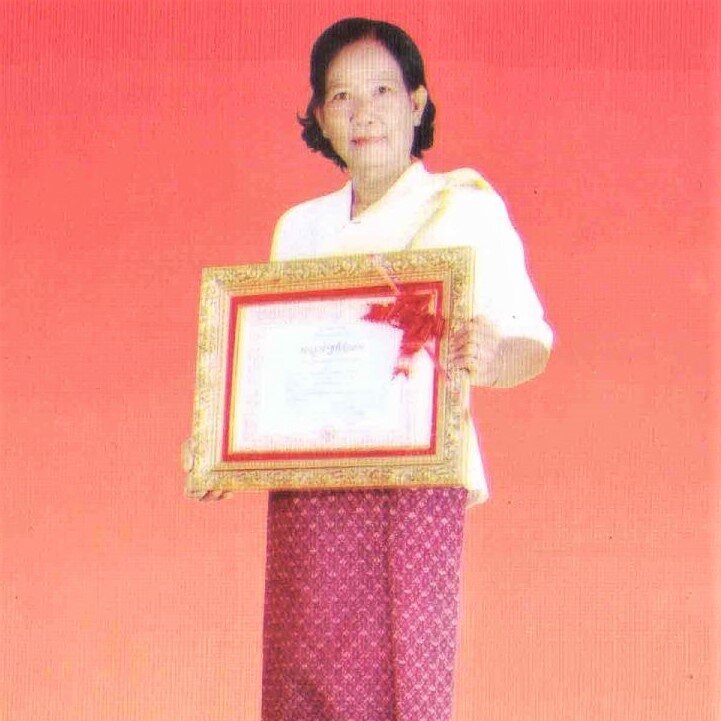
Narom Keo
Keo Narom កែវ ណារុំ (6 Feb. 1946, Phnom Penh) is a Cambodian writer, editor, musicologist and the vice-director of the Committee on Culture and Arts at the Ministry of Culture and Fine Arts of Cambodia.
She is the author of several books on Cambodian musical instruments and musical forms, including Khmer Music Heritage (granted by the Toyota Foundation).
Australian writer Arnold Zable wrote an essay about her life and tribulations in the midst of Khmer Rouge persecution,‘The Ballad of Keo Narom’, (part of The Watermill book).
About the Author
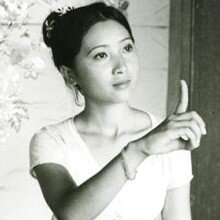
Sisaphanta Prum
Prum Sisaphantha ព្រំ សុីសាផាន្ធា (3 June 1956, Phnom Penh) is a language teacher and historian of Khmer classical dance who, after studying in Singapore and Russia, was a trainee and researcher with the Khmer Classical Ballet from 1973 – 1975 before being forced into agricultural labor in Battambang and into exile by the Khmer Rouge régime.
While living in Japan, she decisively contributed to the research on Khmer Apsara dance, also training several Japanese and Cambodian dancers to master the time-honored performing art form. She is currently teaching dance at RUPP, Phnom Penh.
Main photo by Colin Grafton, 1974.

